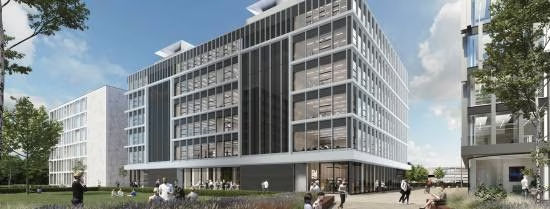In July of this year, the trade journal Cobouw paid extensive attention to the innovative ventilation system of the new multifunctional educational building on Campus Woudestein. The system runs on solar heat and wind, which means that less electricity is used than with conventional ventilation systems, which consume a lot of energy. Moreover, the revolutionary system takes up less space because no large air handling units are needed on the roof or in the basement to maintain a healthy and comfortable indoor climate. This leaves more space to make optimal use of the roof for installing solar panels.
Cooling without air conditioning
It all sounds very simple, but the development of the innovative system required the necessary headaches and laboratory tests. Main contractor BAM Bouw en Techniek, Paul de Ruiter Architects and Halmos Advisors were spurred on by a call for tenders in which Erasmus University Rotterdam set its sights particularly high. The educational institution asked the market for a building that was not only circular, but also energy-neutral. The parties therefore arrived at the Earth, Wind & Fire (EWF) concept, which Benjamin Bronsema launched in 2013 during his PhD research at TU Delft. This provides a ventilation system without air conditioning in which falling water, sun and wind provide fresh air.
Powered by Nature
The design team - with Bronsema's backing - has further developed the original EWF principle into a 2.0 version, which has been given the name 'Powered by Nature'. This climate system is based on a natural ventilation concept. It works with a solar chimney that, in combination with a humidification system and a venturi hood, generates a natural flow of fresh air. This system is very energy-efficient and ensures a healthy and comfortable indoor climate in the building. Research has shown that this system uses 20% less energy than traditional ventilation systems. In combination with all the other sustainable choices, such as solar panels, this results in an Energy Performance Coefficient of less than zero. This means that the building can provide for its own energy needs and even become energy-positive. Due to the integral design approach, there are no additional costs involved in realising this installation concept and because no large installation spaces are required compared to traditional air handling units, more m² are left over for teaching. An important criterion for Erasmus University Rotterdam.
Article in Dutch



